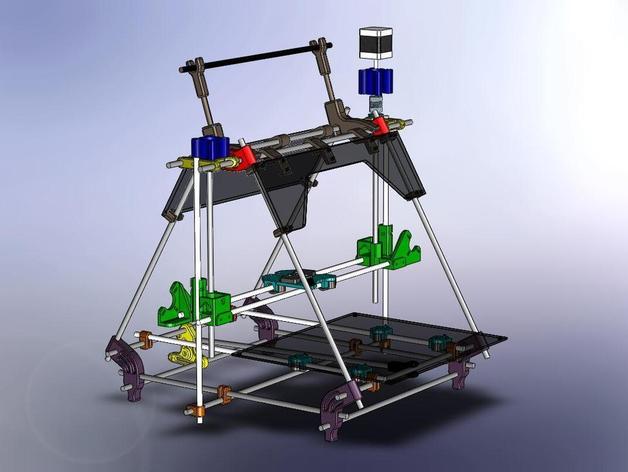
This is a moderately larger 3d printer based on the ever popular Mendel, Prusa.The build envelope in mm is 300,250,150 (x,y,z respectively).There are a lot of subtle differences in this design that I made to suit my own needs. For instance; the X-ends are interchangable and lock onto the smooth rods from the sides to prevent splitting along layers. And the A-side threaded diagonal rods are outside of the front and rear cross rods for better clearance with the extruder at high z-limit. I reconfigured the vertexes to make that possible.NOTE: PLEASE ACCEPT MY APOLOGIES, BUT MY COMPUTER IS NOT ALLOWING CERTAIN FUNCTIONALITY. I JUST REALIZED THAT I HAVEN'T BEEN ABLE TO ENTER TAGS. I HAVE BEEN ENTERING THEM, BUT THEY DONT INPUT. YET THEY DO FROM A DIFFERENT COMPUTER. ALSO, I'M NOT SEEING COMMENTS ON ANY COMPUTER. JUST GETTING EMAILS. AGAIN, SORRY. Unfortunately, this really isn't instructions, but more of a teaser since this is a work in progress. I will have to update it as I go. At this point, I will only include pictures and a 3D PDF (download) that will allow full rotational viewing in adobe reader.I decided to build this machine because I believe that the prusa can be enlarged (moderately) providing a couple things are addressed. Of course I could go all out and build a mendelmax, but I'd like to rise to the challenge rather than succomb to brute strength. I do like the mendelmax tho. I agree with most that the prusa is just barely stout enough to handle high speed directional changes in tight fills in it's current form. But I think it would be easy enough to reinforce it to accomodate a slightly larger frame. I chose to use polycarbonate gusset panels, front and rear to help with that, and on my assembled frame the difference was night and day. So that addressed the x-axis issues with a taller machine.The next thing that became obvious to me is that the y-axis belt tension will really work on the front and rear threaded cross rods, so I fitted the y-axis with a strut that spans the y-pulleys. It sits in the stepper bracket and has a fork end that is adjustable for tensioning. My final concerns are with the x and y smooth rods. The x-rods are 3" shorter than the y and have a fixed, lighter load, so I decided to look into deflection of the y rods first.With the frame assembled, and on a granite surface table, I applied a load to the rods and measured deflection. Here's what I found:6 lbs of pressure induced .16mm of actual deflection along the smooth rods. Any load under that was ridiculous to try to detect. I had to take several measurements along the rods to be accurate.There was some other deflection/settling that occured on the cross rods that had to be isolated from the actual smooth rod deflection. The other rods (threaded) can be dealt with easily enough if I find it necessary.I'm pretty sure that deflection will not be an issue. Yes, this is a static load and not a load under a jittering machine printing a tight fill, but I doubt that the machine will ever even see 4 lbs, let alone 6! In fact, I think it will rarely have more than 3 lb total (including bed weight and parts).I think the biggest issue will be heating/warpage, but I do pretty well right now on a heated bed with PLA on fairly large prints. The prints that I need a larger bed for aren't much bigger and are actually generally short. The taller prints have a smaller footprint, so it makes sense. ABS is another story. I would likely only do small ABS parts no matter what machine I was using, unless I had a heated chamber, or maybe radiant heat? Hmmm...I hope to keep this interesting. Thanks for looking:)
- 0 inches x 0 inches x 0 inches
- this product is 3D printed
- 16 available colors
- material is a strong plastic
- free delivery by Sep 08
- 0 parts

